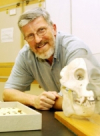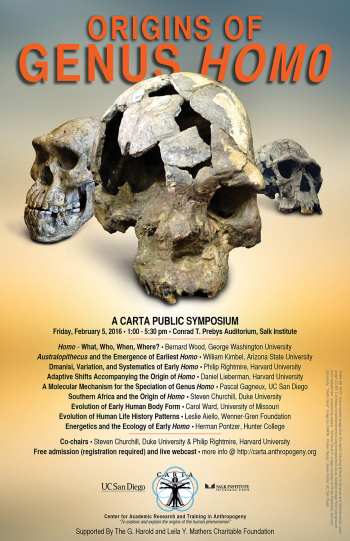Origins of Genus Homo
Steven Churchill, Duke University
Philip Rightmire, Harvard University
Summary
Despite discoveries of remarkable new fossils in recent years, the evolutionary events surrounding the origins of genus Homo are incompletely understood. This CARTA symposium explores evidence bearing on the emergence of our genus, focusing on possible antecedents to Homo, changes in diet and body form as Australopithecus evolved toward Homo, ancient species within the genus, and evolutionary processes likely operating 2.5 - 1.5 million years ago.
Media for each talk can be played by clicking on icons in the table below, or by clicking on the individual talk titles below and then the attachment file at the bottom of the page.
| Speakers | Media | Session |
|---|---|---|
 Margaret Schoeninger |
|
Welcome |
 Steven Churchill |
|
Opening Remarks |
 Bernard Wood |
|
Homo - What, Who, When, Where? The search for the “origin of Homo” suggests we know what we are looking for, so unless we are clear about that, then how will we know when we have found it? It also conflates several “origins” problems. When did our ancestors and close relatives look the way we expect the earliest members of our genus to have looked? When did our ancestors and close relatives behave in the way we expect the earliest members of our genus to have behaved? The search for the origin of a living genus can be... read more |
 William Kimbel |
|
Australopithecus and the Emergence of Earliest Homo The age of origin of the Homo lineage is thought to have fallen in the time period between 2.5 and 3.0 Ma. The relevant fossil record in Africa is, however, notoriously poor, thwarting attempts to discern the pattern of earliest Homo evolution and delineate its proximate causes. Recent fossil discoveries in the Afar rift of Ethiopia push the Homo lineage back to 2.8 Ma. Although separated in time from Australopithecus afarensis, a potential ancestor, by only two-hundred thousand years, these... read more |
 Philip Rightmire |
|
Dmanisi, Variation, and Systematics of Early Homo Our genus evolved in Africa, and its members were confined to that continent for a long period. The site of Dmanisi in the Georgian Caucasus records the oldest known occupation of Eurasia, beginning ca. 1.85 Ma ago. At least five individuals are documented from skulls and postcranial bones preserved within a thin sedimentary succession, and there is archaeological and taphonomic evidence relating to the life ways of the Dmanisi hominins. A shared anatomical bauplan, comparisons of variation in... read more |
 Daniel Lieberman |
|
Adaptive Shifts Accompanying the Origin of Homo Many aspects of the origin of the genus Homo are murky and cannot be resolved with the available data. There is no clear way to define the genus let alone its species, and the evolutionary relationships among the relevant taxa are open to question. Although few experts question the notion that Homo differs significantly from Australopithecus, there is little agreement on what adaptive strategies facilitated change within the Homo clade. Proposed behavioral differences include trekking,... read more |
 Pascal Gagneux |
|
A Potential Molecular Mechanism for the Speciation of Genus Homo The human species underwent a watershed change in the biochemical composition of its cell surfaces, via a genetic event estimated to have occurred ~2-3 million years ago, which is also the apparent period of the emergence of the genus Homo. A loss-of function mutation occurred in CMAH (responsible for transforming the cell surface sialic acid Neu5Ac into its derivative Neu5Gc), a change affecting many millions of molecules per cell, altering diverse biological functions. Analyses of fossil... read more |
 Steven Churchill |
|
Southern Africa and the Origin of Homo In the last seven years, two hominin species possessing a mixture of primitive (Australopith-like) and derived (Homo-like) morphology – Australopithecus sediba and Homo naledi – have been discovered in South Africa. Opinions differ as to the phylogenetic (evolutionary) position of these species and their relevance to our understanding of the origins of the genus Homo, and especially to the emergence of Homo erectus. Given that southern Africa is a center of mammalian endemism, and that... read more |
 Carol Ward |
|
Evolution of Early Human Body Form Upright walking is the hallmark of human evolution, with the earliest definitive hominins showing adaptations throughout their skeletons for habitual terrestrial bipedality. Yet the earliest committed bipeds, the australopiths, were not built exactly like the members of our genus, Homo. It has traditionally been argued that this means climbing trees was still important for australopiths, and the shift to a more fully human-like body plan signaled the abandonment of tree-climbing, even though... read more |
 Leslie Aiello |
|
Evolution of Human Life History Patterns Humans are unique in more ways than simply our large brains, language abilities or two-footed walking. We also differ in our life histories or in the tempo and mode of the lives we live. We occupy the slow lane and have unusually long childhoods and long lifespans, while at the same time weaning our infants early and producing the next offspring in relatively rapid succession. This strange life pattern relates specifically to the energy demands of the large human brain. We know that in modern... read more |
 Herman Pontzer |
|
Energetics and the Ecology of Early Homo Life takes energy: essential tasks like growth, maintenance, reproduction, and movement all require metabolic energy expenditure. Compared to our closest relatives, the great apes, humans have larger brains, faster reproduction, greater physical activity levels, and longer lifespans, indicating major evolutionary changes in the ways our bodies expend energy. In this talk, I investigate humans’ evolving metabolic strategy and its origins in the fossil record. Comparisons with living apes show... read more |
 Philip Rightmire  Speakers and Audience  Ajit Varki |
|
Question and Answer Session, Closing Remarks |
| Attachment | Size |
|---|---|
| 140.28 KB | |
| 209.41 KB | |
| 138.35 KB | |
| 672.14 KB | |
| 204.95 KB |
If you enjoy this event, please consider supporting CARTA's quest to explore and explain the human phenomenon.


